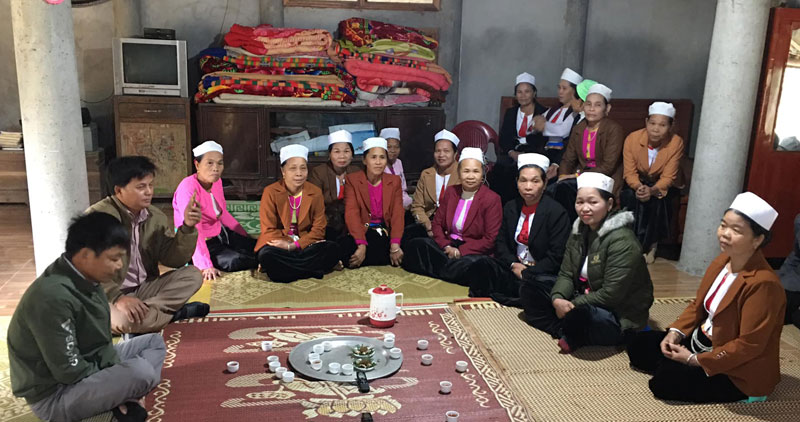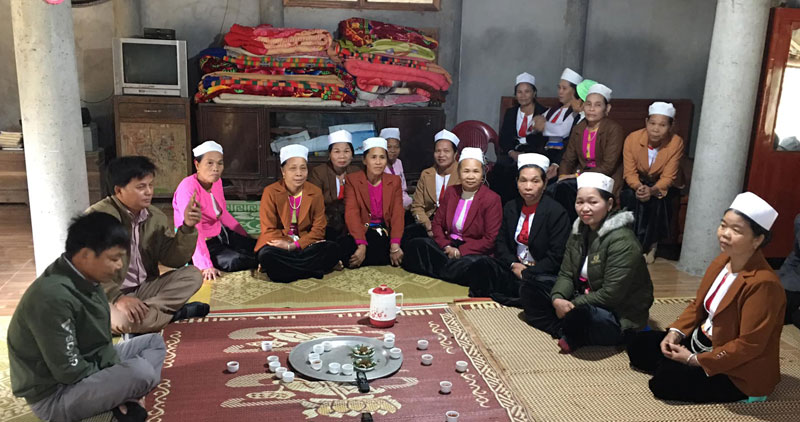
(HBO) - The People’s Committee of northern Hoa Binh province promulgated a plan in October 2016 to bring the Muong ethnic minority group’s scripts into life in order to preserve and promote its traditional cultural values.
 A group of Muong folk art collectors meet with
artisans in Nang hamlet, Chi Thien commune, Lac Son district, to introduce the Muong
ethnic minority group’s scripts to local people.
A group of Muong folk art collectors meet with
artisans in Nang hamlet, Chi Thien commune, Lac Son district, to introduce the Muong
ethnic minority group’s scripts to local people.
To implement the teaching and learning of the Muong
scripts, from early 2017, the provincial information portal updated direction
documents of the provincial Party Committee and People’s Committee on
implementing communications in the field.
The Hoa Binh Newspaper has opened a Muong language
page integrated on its e-newspaper, including sections: politics, economy,
culture-tourism, education, defence-security, and sports. It also produces
three clips for Muong online television programme a month.
Besides the Hoa Binh Newspaper and Television,
most of departments and sectors in the province have encouraged officials and
people to learn about the Muong ethnic scripts.
In 2019, the provincial Department of Science
and Technology approved the outcome of a project compiling teaching and
learning materials of the Muong scripts, which enable Muong language speakers
to use in their daily work.
In January 2019, the provincial Party
Committee’s Board for Information and Education and the Department of Science
and Technology jointly organised a conference to hand over the Muong teaching
and learning materials to the Department of Science and Technology, the
Department of Information and Communications, the Department of Education and
Training, the Department of Culture, Sports and Tourism, the provincial Television,
the political school, and the Hoa Binh Newspaper to bring the Muong ethnic
scripts to life.
In late October 2019, the provincial political
school opened a training course on the Muong ethnic scripts for 50 trainees who
are officials and lecturers at school./.
With an increasingly vibrant and widespread emulation movement aimed at building cultured residential areas and cultured families, Yen Thuy District has been making steady progress toward improving both the material and spiritual well-being of its people, while fostering a civilized, prosperous, beautiful, and progressive community.
Once lacking recreational spaces and community facilities, Residential Group 2 in Quynh Lam Ward (Hoa Binh City) has recently received attention for the construction of a new, spacious, and fully equipped cultural house. The project followed the model of state support combined with public contributions in both labor and funding.
The "All people unite to build cultural life" movement, which has been effectively integrated with Kim Boi district’s socio-economic development goals, is fostering a lively spirit of emulation across local residential areas, hamlets, villages, public agencies, and enterprises. In addition, through the initiative, traditional cultural values are being preserved and promoted, while community solidarity and mutual support in poverty reduction and economic development are being strengthened.
A working delegation of the Hoa Binh provincial People’s Committee led by its Permanent Vice Chairman Nguyen Van Toan on June 11 inspected the progress of a project to build the Mo Muong Cultural Heritage Conservation Space linked to tourism services in Hop Phong commune, Cao Phong district.
Born and growing in the heroic land of Muong Dong, Dinh Thi Kieu Dung, a resident in Bo town of Kim Boi district, in her childhood was nurtured by the sweet lullabies of her grandmother and mother. These melodies deeply imprinted on her soul, becoming an inseparable part of her love for her ethnic group's culture. For over 20 years, this love for her hometown has driven Dung to research, collect, and pass down the cultural values of the Muong people to future generations.
In the final days of May, the Ethnic Art Troupe of Hoa Binh Province organized performances to serve the people in remote, mountainous, and particularly disadvantaged areas within the province. These were not just ordinary artistic shows, but they were the meaningful journeys aimed at spreading cultural values, enhancing the spiritual life of the people and contributing to the preservation of ethnic minority cultural identities.



 A group of Muong folk art collectors meet with
artisans in Nang hamlet, Chi Thien commune, Lac Son district, to introduce the Muong
ethnic minority group’s scripts to local people.
A group of Muong folk art collectors meet with
artisans in Nang hamlet, Chi Thien commune, Lac Son district, to introduce the Muong
ethnic minority group’s scripts to local people.